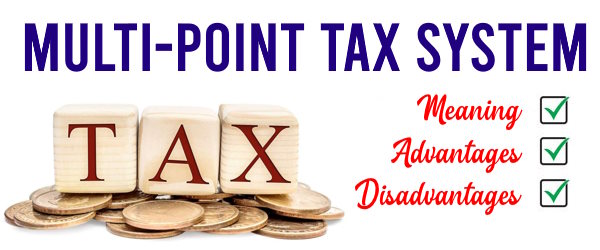Multi-Point Tax System | Meaning | Advantages | Disadvantages
Table of Contents
What is Multi-Point Tax System?
Multi-Point Tax (MPT) is a tax system in which taxes are imposed at multiple points in the production and distribution chain of goods and services. MPT is also known as Value-Added Tax (VAT) in many countries.

Under the MPT system, taxes are levied at each stage of production or distribution, based on the value added by the respective businesses in the chain. This means that businesses are taxed on the value they add to the product or service, rather than on the total value of the product or service.
For example, if a manufacturer produces a product and sells it to a wholesaler, the manufacturer will charge a tax on the value it has added to the product. When the wholesaler sells the same product to a retailer, the wholesaler will charge a tax on the value it has added to the product, which includes the tax already paid by the manufacturer. Finally, when the retailer sells the product to the end consumer, it will charge a tax on the value it has added to the product, which includes the taxes already paid by the manufacturer and the wholesaler.
The MPT system is considered to be more efficient than other tax systems, as it reduces the chances of tax evasion and fraud. It also provides transparency in the tax collection process and simplifies the tax system by eliminating the need for multiple taxes and exemptions.
MPT is used by many countries around the world, including most European countries, Canada, and Australia, among others.
Advantages of Multi-Point Tax System
Multi-Point Tax (MPT) or Value-Added Tax (VAT) has several advantages over other forms of taxation. Here are some of the key advantages:
1. Simplicity
MPT is a simple tax system that reduces the complexity of tax administration. It eliminates the need for multiple taxes and exemptions and streamlines the tax collection process.
2. MPT is transparent
MPT provides transparency in the tax collection process. It allows businesses to see exactly how much tax they are paying at each stage of production or distribution, which increases accountability and reduces the likelihood of tax evasion.
3. MPT is efficient
MPT is an efficient tax system that reduces the burden on taxpayers and tax authorities. It reduces the costs of tax collection and increases revenue for the government.
4. Fairness
MPT is a fair tax system that taxes individuals and businesses based on their ability to pay. It is a consumption-based tax, which means that individuals and businesses pay tax based on the amount of goods and services they consume.
5. MPT encourages compliance
MPT encourages compliance by businesses as they have a financial incentive to properly account for and pay the tax. This reduces the likelihood of tax evasion and fraud.
6. MPT enhances competitiveness
MPT can enhance the competitiveness of a country’s economy as it reduces the tax burden on businesses, particularly on exports. This makes exports more competitive in the global market.
7. Generates revenue
MPT generates significant revenue for the government, which can be used for public services and investment in infrastructure.
Overall, MPT is a fair, transparent, efficient, and simple tax system that encourages compliance and enhances competitiveness. It has been adopted by many countries around the world and has proven to be an effective means of generating revenue for the government while reducing the tax burden on individuals and businesses.
Disadvantages of Multi-Point Tax System
While Multi-Point Tax (MPT) or Value-Added Tax (VAT) has several advantages, there are also some disadvantages to consider. Here are some of the key disadvantages:
1. MPT is Regressive
MPT can be a regressive tax system, which means that it can have a greater impact on low-income households than high-income households. This is because low-income households tend to spend a higher proportion of their income on goods and services, which are subject to MPT.
2. Administrative complexity in MPT
While MPT is designed to simplify tax administration, it can be complex to administer in practice. Businesses must keep accurate records of the tax they have paid and the tax they have charged at each stage of production or distribution, which can be time-consuming and costly.
3. MPT Increases costs
MPT can increase costs for businesses, particularly small businesses. This is because they may not have the resources to properly account for and pay the tax, which can lead to penalties and fines.
4. MPT Encourages evasion
While MPT is designed to reduce the likelihood of tax evasion, it can also encourage evasion. This is because businesses may try to avoid paying the tax by under-reporting their sales or over-reporting their expenses.
5. MPT can be difficult to implement
MPT can be difficult to implement in countries with a large informal sector or weak tax administration. This is because businesses in the informal sector may not be registered for tax, which makes it difficult to collect the tax.
6. MPT Impacts international trade
MPT can impact international trade as it can increase the cost of imports and decrease the competitiveness of exports. This can lead to trade imbalances and reduce the overall efficiency of the global economy.
Overall, MPT is a complex tax system that can be regressive, increase costs for businesses, and be difficult to implement in some countries. While it has several advantages, governments must carefully consider these disadvantages when deciding whether to adopt MPT.

